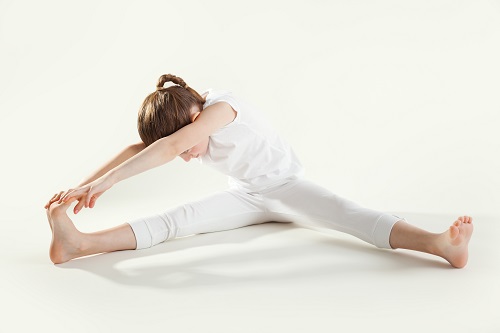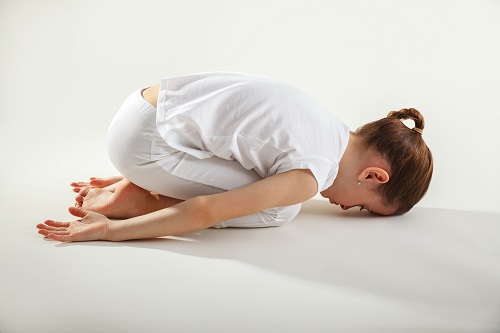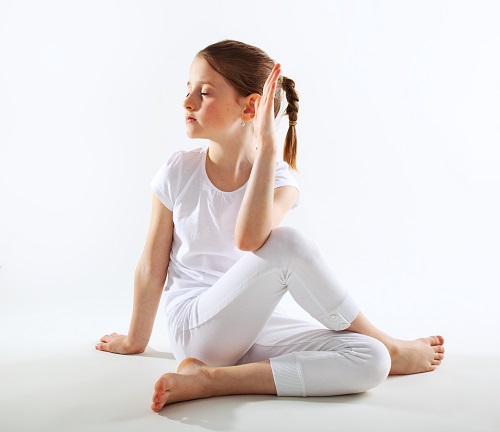Yoga for Kids: Helping Children Suffering from Chronic Stomach Pain

Childhood should be a time to play and have fun—not a time to struggle with chronic stomach pain! Yet this remains the reality for many children today.
The condition, known as functional abdominal pain, comes with a list of stomach issues, including pain and nausea among others. What they all have in common is that none of them show a physical cause upon testing. Doctors believe, though, that stress and anxiety may be to blame.
With no identifiable cause, treatments of stomach pain in children can range from dietary changes to medications, but recent studies show yoga may be one of the more effective treatments options.
Studying Yoga for Abdominal Pain
In a small pilot study, researchers had children with chronic stomach pain go through 10 yoga classes, while they tracked their degree of pain. Regardless of age, the children participating in the yoga classes reported an improvement in their pain, which continued at least three months after the completion of the yoga classes.
Parents of the kids enrolled in the yoga classes were also asked to rate their children’s quality of life. They too noticed an improvement in their children’s overall quality of life.
Stress and Stomach Pain
While the study results are very preliminary, because of the small sample and limited scope of the study, they are in line with what we know about the link between stress and chronic stomach pain in children.
Researchers have long believed a connection exists between pain and stress—especially stomach pain. You’ve heard of a gut feeling, and you may yourself have experienced situation where you were so nervous you were sick to your stomach. While this is a subjective experience, increasingly, researchers are uncovering a connection between how we feel and pain in the gut, often referred to as the gut-brain connection.
Essentially, when we experience negative emotions, it leads to a physical response, which often takes the form of tension in the gut that results in pain and stomach upset.
Why Yoga Helps the Stomach
In children who have no outlet for their stress, it’s not uncommon for the gut-brain connection to be severe and result in chronic and debilitating stomach upset. Yoga can give children a tool to improve the way they handle negative emotions, helping to calm the mind and create a happier stomach.
On a physical level, yoga boosts the parasympathetic nervous system (PNS)—commonly referred to as the rest and digest system. When it’s in check, the PNS slows the heart rate, increases intestinal and gland activity, and calms the gastrointestinal tract, thereby easing stomach pain.
Poses to Calm the Mind and Relieve the Stomach
If your child is struggling with stomach aches and doctors have ruled out a physical cause, here are four simple poses to try.
 Forward fold (Uttanasana or Paschimottanasana): Either standing or seated, simply elongate the spine and fold at the hips, keeping the back as straight as possible. Hands can rest on the thighs, shins or lower depending on the position. This pose is incredibly calming and is a powerful way to tune out the rest of the world and simply breathe.
Forward fold (Uttanasana or Paschimottanasana): Either standing or seated, simply elongate the spine and fold at the hips, keeping the back as straight as possible. Hands can rest on the thighs, shins or lower depending on the position. This pose is incredibly calming and is a powerful way to tune out the rest of the world and simply breathe.
Legs up wall: This pose seems so simple, but by lying on the floor, eyes closed, with hips close to the wall and legs extended straight up, the mind and body reach a state of calm and relaxation that allows everything to just slow down a little.
 Child’s pose (Balasana): It sounds appropriate—and it is. In a kneeling position with hips resting on the heels and knees slightly spread, simply fold forward and allow the forehead to rest on the ground. Arms can be stretched straight ahead or along the sides. In this pose, the muscles in the front of the body are relaxed but they are also slightly compressed which helps activate a stagnant digestive system.
Child’s pose (Balasana): It sounds appropriate—and it is. In a kneeling position with hips resting on the heels and knees slightly spread, simply fold forward and allow the forehead to rest on the ground. Arms can be stretched straight ahead or along the sides. In this pose, the muscles in the front of the body are relaxed but they are also slightly compressed which helps activate a stagnant digestive system.
 Simple twists: Twists are also a great way to calm the mind and activate an unhappy digestive system. One of the simplest ones is Bharadvajasana. In a seated position, bend your knees and swing your feet around to the left side so your heels are outside the hips. With your right hand behind you like a tripod, place your left hand on your right knee and twist. This can be held as long as is comfortable before switching sides.
Simple twists: Twists are also a great way to calm the mind and activate an unhappy digestive system. One of the simplest ones is Bharadvajasana. In a seated position, bend your knees and swing your feet around to the left side so your heels are outside the hips. With your right hand behind you like a tripod, place your left hand on your right knee and twist. This can be held as long as is comfortable before switching sides.
It’s important to talk to a doctor, if your child’s stomach issues are chronic, especially if a healthy diet becomes an issue. A regular yoga practice, though, can help just about anyone deal with stress—even if physical symptoms are not showing.
 Liz Rosenblum found her way to the yoga mat as a way to find peace and calm in her crazy former life as a journalist and the days in content marketing. Over the years her practice has focused on an alignment-based style as a way to find relief from chronic hip pain to power yoga to a home practice, but it was Ashtanga where she found her true home and received her RYT-200 at White Orchid in Clearwater, Florida. She is passionate about the power of yoga to heal the mind and body, and continues to be amazed that no matter how many times a posture is practiced, one slight adjustment can change it exponentially. She is thankful to have the online yoga community of YogaUOnline as a place to share her passion and learnings with others.
Liz Rosenblum found her way to the yoga mat as a way to find peace and calm in her crazy former life as a journalist and the days in content marketing. Over the years her practice has focused on an alignment-based style as a way to find relief from chronic hip pain to power yoga to a home practice, but it was Ashtanga where she found her true home and received her RYT-200 at White Orchid in Clearwater, Florida. She is passionate about the power of yoga to heal the mind and body, and continues to be amazed that no matter how many times a posture is practiced, one slight adjustment can change it exponentially. She is thankful to have the online yoga community of YogaUOnline as a place to share her passion and learnings with others.



